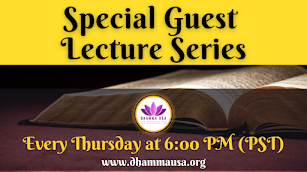Mindfulness of the Breath - Ānāpānasati
From the book by Venerable U Paññānanda (Intagaw-Pa Auk)
Introduction
The Four Noble Truths are the foundations of the Buddha's teachings. Through the practice of the Buddha's teachings, we can attain supreme Nibbāna, Cessation of Suffering. So, if we want to attain supreme Nibbāna, Cessation of Suffering, we must follow The Buddha's teachings. These Noble Truths are:
- The Noble Truth of Suffering
- The Noble Truth of the Origin of Suffering
- The Noble Truth of the Cessation of Suffering
- The Noble Truth of the Path Leading to the Cessation of Suffering.
 Unless we know and see The Four Noble Truths, we cannot realize The Buddha's Teachings. The Buddha taught the Four Noble Truths for us to realize the Third Noble Truth, Nibbāna. This means that we cannot put a complete end to suffering (we cannot attain the Third Noble Truth - Nibbāna) unless we have first fully realized the First Noble Truth (suffering (Dukkha), and fully realize the Second Noble Truth (Samudaya). The aim of the Fourth Noble Truth - the Eightfold Noble Path is to realize the Third Noble Truth (Nibbāna) The only way to realize the First Noble Truth - suffering (Dukkha) and the Second Noble Truth - the origin of suffering (Samudaya) is to first practice the mundane Fourth Noble Truth, the mundane path truth (lokiya magga-sacca), which is the mundane Noble Eightfold Path.
Unless we know and see The Four Noble Truths, we cannot realize The Buddha's Teachings. The Buddha taught the Four Noble Truths for us to realize the Third Noble Truth, Nibbāna. This means that we cannot put a complete end to suffering (we cannot attain the Third Noble Truth - Nibbāna) unless we have first fully realized the First Noble Truth (suffering (Dukkha), and fully realize the Second Noble Truth (Samudaya). The aim of the Fourth Noble Truth - the Eightfold Noble Path is to realize the Third Noble Truth (Nibbāna) The only way to realize the First Noble Truth - suffering (Dukkha) and the Second Noble Truth - the origin of suffering (Samudaya) is to first practice the mundane Fourth Noble Truth, the mundane path truth (lokiya magga-sacca), which is the mundane Noble Eightfold Path.
The First Noble Truth and the Second Noble Truth are mentality, materiality (nāma-rūpa) and their causes - Dependent Origination. By practicing the mundane Noble Eightfold Path systematically (by practicing the Morality, Concentration and Wisdom step by step) a meditator can know and see mentality-materiality and their causes, and then comprehend their impermanent, suffering and non-self nature; that is Vipassanā Meditation by which we are able to realize the supramundane Fourth Noble Truth, the Noble Eightfold Path associated with Supramundane Path Truth (Lokuttara Maggasacca): the Path (Magga) of Stream-Entry (Sotāpatti), Once-Return (Sakadāgāmi), Non-Return (Anāgāmi), and Arahantship.
Before one can do Vipassanā, one must be able to discern ultimate materiality, ultimate mentality and their causes. So, one's path to discernment of materiality is first to develop a Samatha subject of meditation that must be one of the Forty Samatha Subjects (such as ānāpānasati practice) up to Right Concentration (Sammā Samādhi) based on morality. The Buddha explains Right Concentration (Sammā Samādhi) in Mahā Sati Paṭṭhāna Sutta 'The Great Mindfulness Foundation Sutta' as the first jhāna (absorption), second jhāna, third jhāna and fourth jhāna. In the Visuddhi Magga, Right Concentration is explained further as the four jhānas (Rūpa Jhāna), the four immaterial jhānas (Arūpa Jhāna) and Access Concentration (Upacāra Samādhi). Ānāpānasati meditation is one of the very popular meditation subjects. A meditator can develop up to the fourth jhāna in ānāpāna jhāṇa, so the light of wisdom (the light of concentration) is bright, brilliant and radiant at that time. After switching to discernment of materiality meditation (Rūpa Kammatthāna) through the four elements meditation (Catudhātu Vavatthāna) a meditator can see ultimate materiality clearly. Because of the strength and momentum of the fourth-jhāna concentration based on Ānāpānasati a meditator finds that these four elements meditation and discernment of materiality will become deep and fully established.
 In this article series, we discuss the fundamental principle of Ānāpānasati meditation. We also discuss how to focus on the meditation object, and how to overcome some of the obstacles that place on the way. It is not an easy work to achieve jhāna with any concentration meditation. "This ānāpānasati is difficult, difficult to develop, a field in which only minds of the Buddhas, the Pacceka Buddhas, and the Buddha's sons are at home." We discuss important and basic rules that meditators have to understand and apply (mainly in the lower phases to concentration). Hopefully the reader will, after reading this discussion, be able to have deeper understanding on Ānāpānasati up to the attainment of 'Right Concentration', jhāna.
In this article series, we discuss the fundamental principle of Ānāpānasati meditation. We also discuss how to focus on the meditation object, and how to overcome some of the obstacles that place on the way. It is not an easy work to achieve jhāna with any concentration meditation. "This ānāpānasati is difficult, difficult to develop, a field in which only minds of the Buddhas, the Pacceka Buddhas, and the Buddha's sons are at home." We discuss important and basic rules that meditators have to understand and apply (mainly in the lower phases to concentration). Hopefully the reader will, after reading this discussion, be able to have deeper understanding on Ānāpānasati up to the attainment of 'Right Concentration', jhāna.
May you succeed in Ānāpānasati meditation!
May you attain the highest in the Buddha's teaching!
(Images taken at Big Bear Meditation Center, California)
In the Buddha's Teaching there are threefold trainings:
- Morality - Sīla
- Concentration - Samādhi
- Wisdom - Paññā
"Such is the morality; such is concentration; such is wisdom. When morality is fully developed, concentration is of great fruit and benefit; when concentration is fully developed, wisdom is of great fruit and benefit." (1)
 Sīla is the first of the threefold training. To develop Samādhi and Paññā, Sīla training is an important foundation. The meditators have to undertake the eight precepts during the retreat. If meditators stain or break their precepts, they can purify them by taking the precepts again. Most of the meditators observe the morality well, but to observe and purify them again, they undertake the precepts every morning.
Sīla is the first of the threefold training. To develop Samādhi and Paññā, Sīla training is an important foundation. The meditators have to undertake the eight precepts during the retreat. If meditators stain or break their precepts, they can purify them by taking the precepts again. Most of the meditators observe the morality well, but to observe and purify them again, they undertake the precepts every morning.
When we are established in morality, we can practice mental training; here mental training is meditation practice. There are two types of meditation, namely, Samatha (tranquility meditation) and Vipassanā (Insight Meditation). Samatha is the development of wisdom. Of these two, Samatha is a very important foundation for a Vipassanā.(2)
Strong and deep concentration is the proximate cause for insight. Only strong and deep concentration (access or absorption concentration) can know and see things (objects of Vipassanā) as they really are. (3) By practicing Samatha, we can cultivate access or absorption concentration which is Jhāna, and can then proceed to develop wisdom, which is Vipassanā meditation.
Footnotes:
- Dīgha Nikāya, 16.2.4 "Mahāparinibbāna Sutta" - Great Parinibbāna Discourse.
- It is explained by the Buddha in, for example, the 'Samādhi Sutta' - 'The Concentration Sutta' of the 'Sacca Saṃyutta' - 'Section on the Truths': Develop concentration (samādhi), bhikkhus, concentrated (samāhito), bhikkhus, a bhikkhu according to reality understands. Saṃyutta Nikāya. V.XII.i.1; And also see: "samāhito yathābhūtaṃ jānāti passati." (A.3.259, Myanmar edition).
- The second benefit of jhāna concentration is the benefit of vipassanā. This is called vipassanā-basis-jhāna (vipassanā-pādaka-jjhāna). Visuddhimagga.xi.362.
What is Samatha?
The word samatha (serenity) is a general term for concentration. The word is almost synonymous with concentration (samadhi).
Samatha = Samādhi
Samādhi
 Before we start to discuss about Samatha practice, we should know first what the concentration is. We can say that it is the mental ability to direct all your effort and attention on one thing without thinking of other things. It is the head of non-distraction(1). In texts, it is mentioned as 'mental one-pointedness' (One pointedness of the mind - cittassa ekaggatā)(2), so, Samatha meditation is to develop strong and deep concentration (one-pointedness) on one object.
Before we start to discuss about Samatha practice, we should know first what the concentration is. We can say that it is the mental ability to direct all your effort and attention on one thing without thinking of other things. It is the head of non-distraction(1). In texts, it is mentioned as 'mental one-pointedness' (One pointedness of the mind - cittassa ekaggatā)(2), so, Samatha meditation is to develop strong and deep concentration (one-pointedness) on one object.
Samatha = Samādhi
Samādhi
 Before we start to discuss about Samatha practice, we should know first what the concentration is. We can say that it is the mental ability to direct all your effort and attention on one thing without thinking of other things. It is the head of non-distraction(1). In texts, it is mentioned as 'mental one-pointedness' (One pointedness of the mind - cittassa ekaggatā)(2), so, Samatha meditation is to develop strong and deep concentration (one-pointedness) on one object.
Before we start to discuss about Samatha practice, we should know first what the concentration is. We can say that it is the mental ability to direct all your effort and attention on one thing without thinking of other things. It is the head of non-distraction(1). In texts, it is mentioned as 'mental one-pointedness' (One pointedness of the mind - cittassa ekaggatā)(2), so, Samatha meditation is to develop strong and deep concentration (one-pointedness) on one object.
It is because a meditator has to develop deep and stable concentration by focusing on one meditation object that a meditator should determine to practice one meditation subject only. So, we would normally suggest leaving aside all other old practices while practicing the currently chosen meditation subject.
Actually concentration is of many sorts (bahuvidho) and has various aspects. We shall confine ourselves to the kind intended here, calling the concentration profitable unification of mind (kusalacittekaggatā samadhi). Its function is to eliminate distraction.
Actually concentration is of many sorts (bahuvidho) and has various aspects. We shall confine ourselves to the kind intended here, calling the concentration profitable unification of mind (kusalacittekaggatā samadhi). Its function is to eliminate distraction.
(1) ...avikkhepasisañca samādhi. (paṭisambhidāmagga pāli. a) mahāvaggo, b) Ñānakathā, 35. Samasīsaṭṭhañāṇaniddeso)
(2) "Cittassa ekaggatā" is rendered as 'unification of mind' in the sense of harmony of consciousness and its concomitants in focusing on a single object. It is also rendered as 'one-pointedness of mind' in that sense, or in the sense of the focusing of a searchlight. This term is a synonym for samādhi (samatha = samādhi).
(2) "Cittassa ekaggatā" is rendered as 'unification of mind' in the sense of harmony of consciousness and its concomitants in focusing on a single object. It is also rendered as 'one-pointedness of mind' in that sense, or in the sense of the focusing of a searchlight. This term is a synonym for samādhi (samatha = samādhi).
Sources:
- A Companion Volume to Brief Discussion on Ānapānasati (Mindfulness of the breath) by Venerable U Paññānanda (Intagaw-Pa Auk)
- Image taken at Lankarama Buddhist Institute, La Puente, California.














































0 comments:
Post a Comment
Your comments and feedback are very helpful to us in improving our posts. We really appreciate your time. Thank you!
Dhamma USA Team.